Key takeaways:
- Beta readers offer valuable feedback that enhances the emotional impact and overall quality of a manuscript.
- Selecting the right beta readers involves finding individuals who understand the genre, provide constructive feedback, and are genuinely enthusiastic about the work.
- Effective communication with beta readers is crucial; specific questions and clear expectations lead to more relevant insights.
- Interpreting feedback requires a balance between embracing valuable critiques and staying true to the author’s vision.
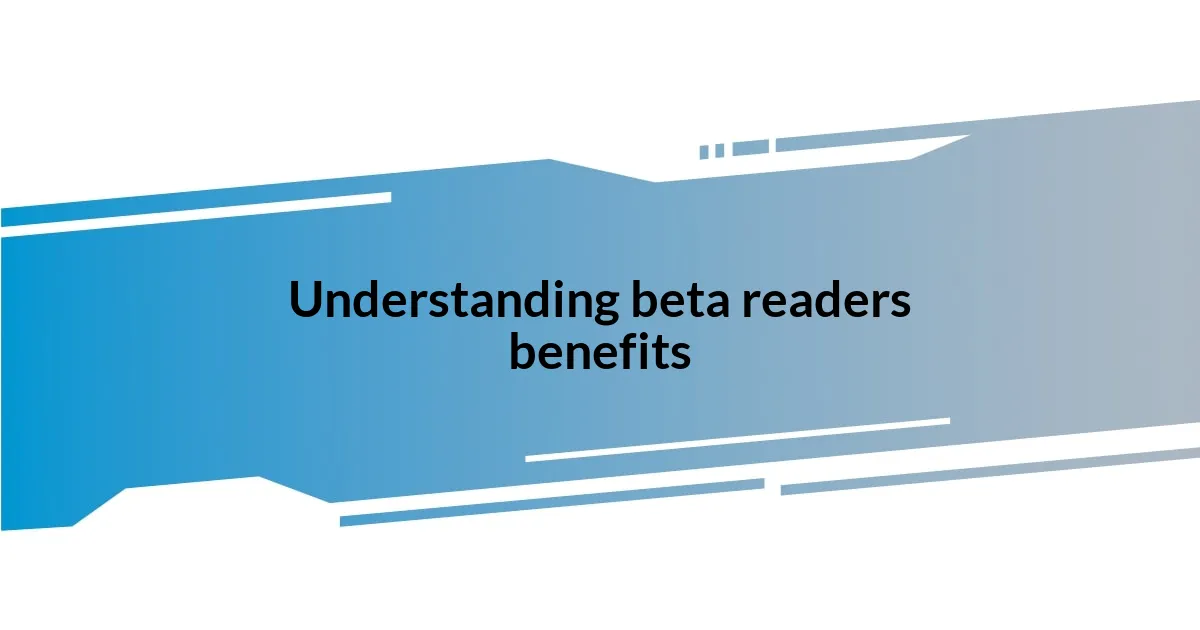
Understanding beta readers benefits
One of the most rewarding aspects of working with beta readers is the fresh perspective they bring to my writing. I remember feeling a mix of excitement and anxiety the first time I handed my manuscript to a close friend who wasn’t afraid to speak her mind. Her candid feedback not only highlighted aspects I hadn’t considered but also validated my narrative choices, helping me grow as a writer.
When I think about the emotional impact of beta readers, I realize how they bridge the gap between isolation and connection. After receiving their feedback, I often find myself feeling a sense of relief, like a weight has been lifted. It’s comforting to know that someone else has engaged with my work, and their insights can guide me toward a stronger, more polished final product. Have you ever felt that rush of adrenaline when someone truly “gets” your story?
Beta readers can act as a litmus test for your writing, revealing what resonates and what falls flat. During one of my writing journeys, I discovered that a scene I thought was powerful elicited a lukewarm response from several readers. This taught me the importance of gauging emotional reactions, reminding me that a writer’s intent might not always equal its effect. Their feedback not only sharpened my narrative but transformed my understanding of storytelling as a collaborative process.
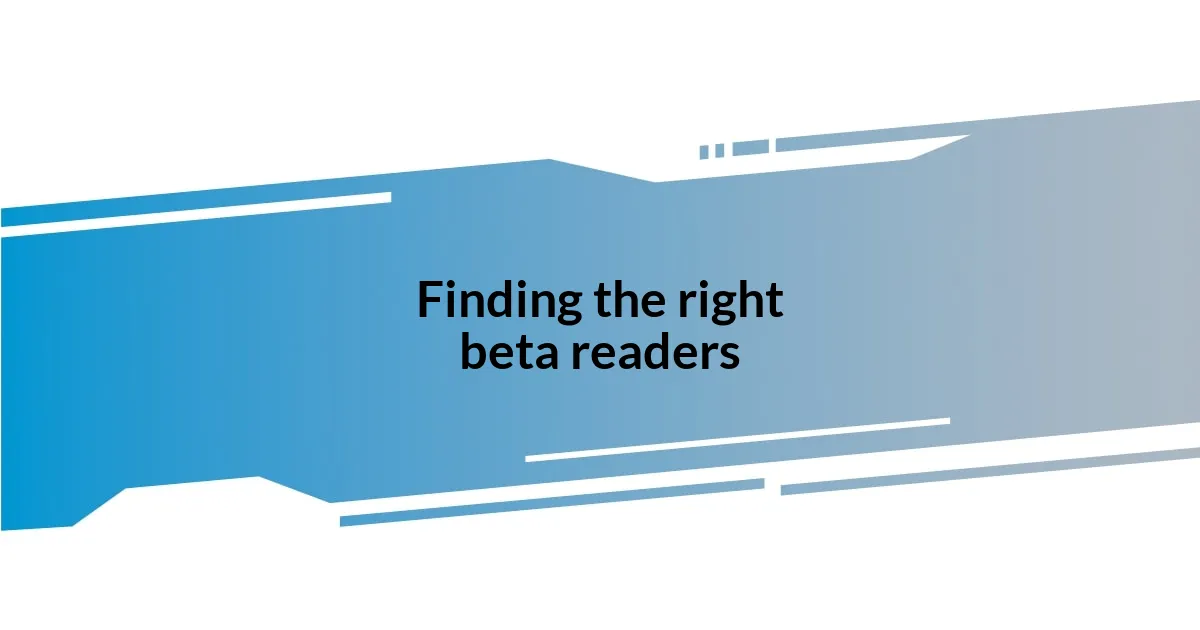
Finding the right beta readers
Finding the right beta readers can feel a bit like searching for a needle in a haystack, but it’s crucial for the success of your work. I remember the excitement of reaching out to different people in my circle, wondering who would be the most valuable in providing that honest, critical eye. Ultimately, I realized that the best beta readers are those who not only appreciate the genre I’m working within but also share a genuine interest in the themes I explore.
Here are some key qualities to consider when seeking out beta readers:
- Familiarity with the Genre: Choose individuals who enjoy and understand the genre you’re writing in.
- Constructive Feedback Style: Opt for readers who can provide feedback that is both honest and encouraging, balancing critique with praise.
- Diverse Perspectives: Look for a mix of backgrounds and experiences to gain varied insights.
- Enthusiasm for Your Work: Select those who are genuinely excited about your story and invested in your characters.
- Availability and Reliability: Ensure they have the time to read and respond thoughtfully within your deadlines.
The journey of finding my own beta readers opened my eyes to the importance of aligning expectations and communication. I once invited a colleague from work, hoping for some solid insights, but I forgot to clarify what type of feedback I was looking for. The result? A detailed critique on grammar and structure, which I hadn’t anticipated at all. It’s in moments like these that I learned the value of having open discussions beforehand so that everyone is on the same page.
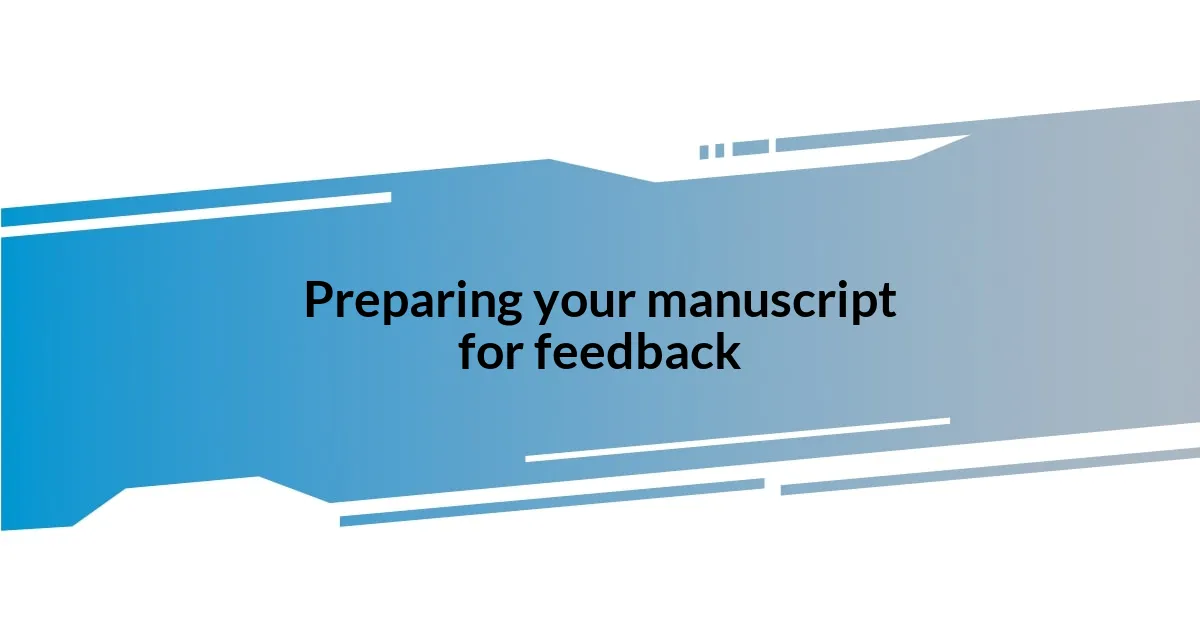
Preparing your manuscript for feedback
Preparing your manuscript for feedback often feels like prepping for a first date; you’re excited yet nervously anticipating the reaction. Honestly, I remember when I first handed over a draft to my beta readers. My heart raced as I anticipated their comments. I started to wonder if I had done enough to make my work shine, realizing that a well-prepared manuscript sets the stage for constructive feedback.
To ensure your manuscript is ready, I’ve found it helpful to take a step back and read through my work with a critical eye. I even create a checklist focused on clarity, pacing, and character development. Just last year, I revisited a story I had set aside and discovered sections that were unclear. This experience reinforced my belief that if I take the time to identify potential pitfalls in advance, my beta readers can focus on providing more meaningful feedback that helps elevate my writing.
Finally, it’s important to communicate your specific needs clearly. I’ve learned this the hard way! One time, I received a barrage of feedback that felt overwhelming because I hadn’t articulated what I was hoping to gain from their insights. It dawned on me that guiding your beta readers allows for targeted feedback that genuinely enhances your manuscript, making it a more efficient and enjoyable process for everyone involved.
| Preparation Tips | Benefits |
|---|---|
| Reading with a Critical Eye | Identifies potential issues before feedback |
| Creating a Checklist | Ensures clarity and focus for beta readers |
| Guiding Feedback Requests | Encourages targeted, meaningful insights |
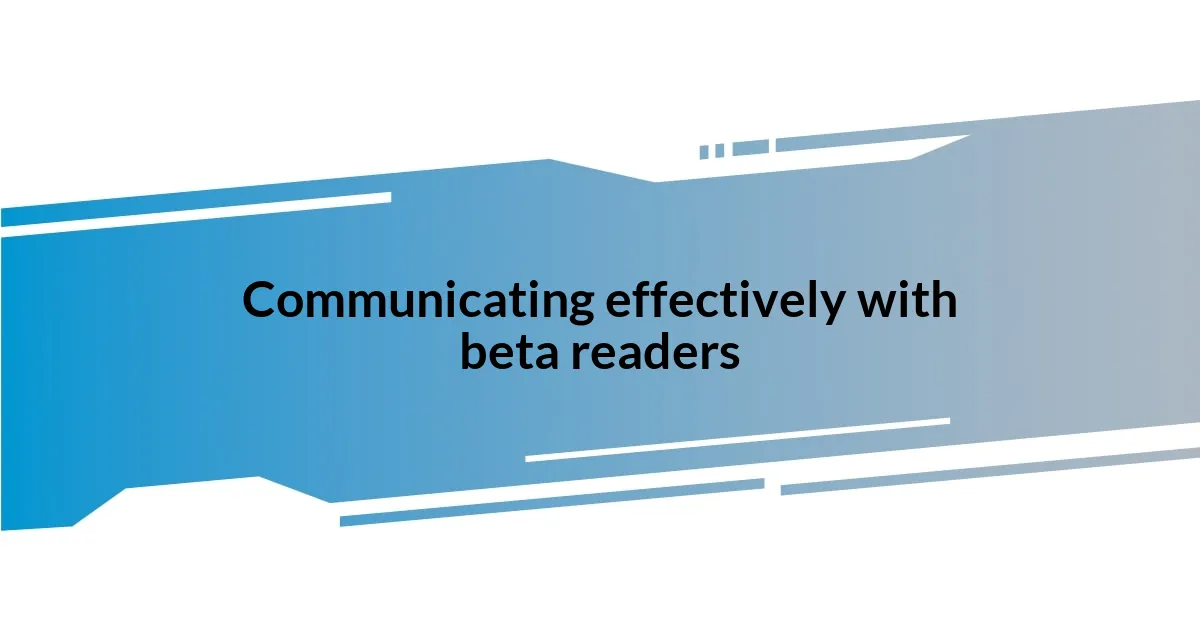
Communicating effectively with beta readers
Effective communication with beta readers can transform your writing experience into a collaborative journey. I recall a time when I shared my manuscript with a group but neglected to explain the areas I struggled with most—character motivation and pacing. Their responses ended up focusing on elements I felt confident about. This taught me the importance of being upfront about my needs, as it fosters deeper conversations and allows beta readers to offer more relevant insights.
I’ve also learned to utilize specific questions when seeking feedback. Instead of asking, “What do you think?” I’ve started asking targeted questions like, “Did the pacing feel right in Chapter 3?” It might seem simple, but this shift has generated richer conversations. My beta readers began to share their genuine thoughts on what truly resonated or fell flat. This shared dialogue turned feedback sessions from vague impressions into focused discussions that enlivened my revisions.
Lastly, I find that expressing gratitude goes a long way. After receiving feedback, I take a moment to thank each reader personally, often highlighting a particular insight they provided that was especially helpful. It not only builds a positive rapport but also encourages them to maintain their enthusiasm for future projects. When we recognize the effort our beta readers put into their critiques, it transforms the process into a shared passion project instead of just a transactional one. How can we foster such an atmosphere of appreciation in our own reader relationships?
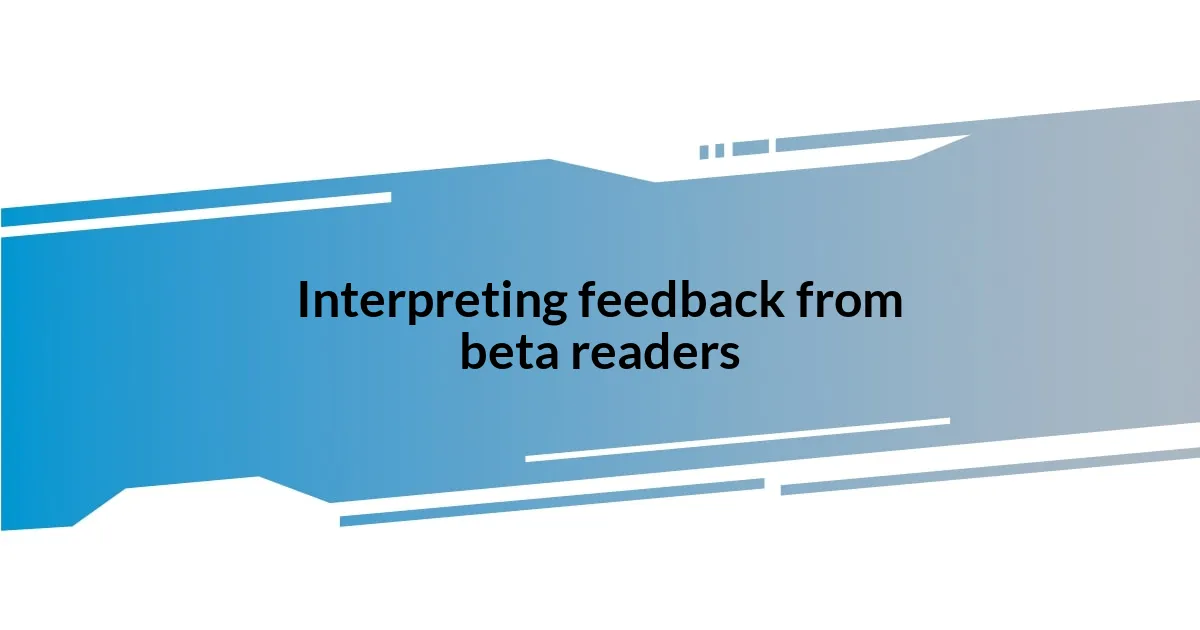
Interpreting feedback from beta readers
Interpreting feedback from beta readers can often feel like decoding a foreign language. I remember receiving a mix of enthusiastic praises and pointed critiques about a character’s arc in my novel. At first, I was torn—should I celebrate the connection readers felt, or dive into the concerns about predictability? Ultimately, I learned to embrace both sides of feedback, recognizing that it can serve as a compass guiding my revision process.
I’ve noticed it’s vital to separate constructive criticism from personal opinions. For instance, one reader expressed frustration with a plot twist that I believed was essential to the story. Initially, my instinct was to defend the choice, but after reflecting on their perspective, I realized this feedback was opening my eyes to how the twist could feel jarring to others. This experience highlighted that sometimes, our attachment to certain ideas can cloud our judgment, making outside perspectives crucial for a balanced narrative.
When I sift through feedback, I also categorize comments into themes—like plot, pacing, character development, and so forth. This practice has helped me not feel overwhelmed by the sheer volume of opinions. There was a moment when I had over twenty pages of comments! Organizing feedback this way allows me to tackle each section systematically, transforming the initial shock into a structured plan for improvement. So, how do you approach interpreting beta feedback without losing sight of your original vision? It’s all about finding that sweet spot between embracing feedback and staying true to your voice.
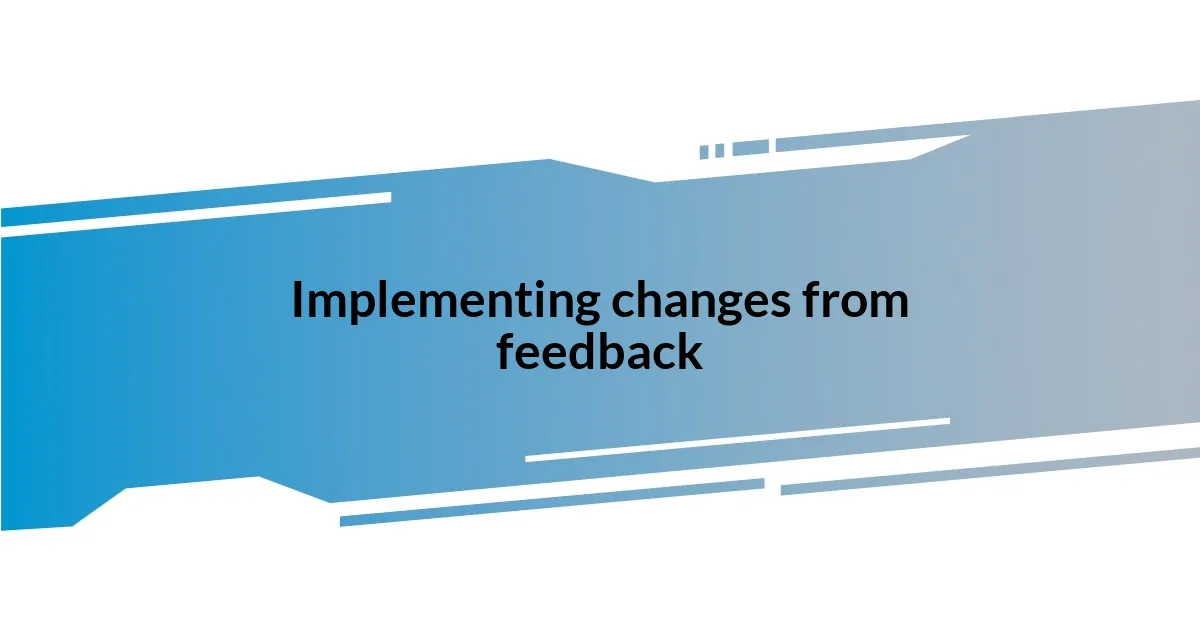
Implementing changes from feedback
Implementing feedback from beta readers is a nuanced process that requires a delicate balance between receptivity and conviction. I recall a situation where a beta reader pointed out that one of my beloved side characters lacked depth. At first, I felt defensive; after all, I cherished that character! But as I revisited those sections, I realized their perspective was spot on. Taking their advice to add more layers transformed that character into a reader favorite, enriching the story in ways I hadn’t anticipated.
When I systematically approached the feedback, I began making changes chapter by chapter. I’d take a day to digest insights before diving into revisions. This pause allowed me to prioritize which feedback resonated most with my vision. For instance, one reader suggested revising an opening scene that I thought was strong. Initially hesitant, I experimented with their suggestions, and the end result was a more gripping start. It was fascinating to see how an outside perspective could illuminate aspects of my writing I had grown too close to see clearly.
Moreover, I’ve learned never to hesitate to ask for clarification. One beta reader mentioned they found a certain subplot confusing, but I wasn’t exactly sure why. I reached out for more details and discovered a narrative thread I’d neglected to tie up. Their insight not only refined the plot but also made me think: how often do we overlook simple clarifications that could profoundly enhance our work? It’s truly enlightening to realize that often, the answers to our biggest writing dilemmas lie just one question away.
